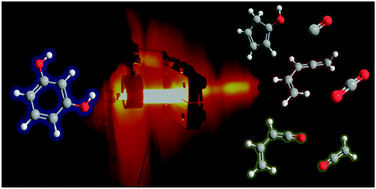Metamorphic meta isomer: carbon dioxide and ketenes are formed via retro-Diels–Alder reactions in the decomposition of meta-benzenediol†
Abstract
The deoxygenation reaction of m-benzenediol (resorcinol), an important lignin model compound, was studied in a hot microreactor. We revealed three decomposition channels by detecting elusive and reactive intermediates and product isomers selectively and found that resorcinol, similarly to catechol (o-benzenediol) and hydroquinone (p-benzenediol), (i) gets decarbonylated to yield hydroxycyclopentadiene. Additionally, (ii) decarboxylation (CO2 loss) yields C5H6 species in a retro-Diels–Alder reaction from a lactone species. Only acyclic products are detected at lower reactor temperatures and the most stable C5H6 isomer, cyclopentadiene (c-C5H6), is only observed at higher temperatures. Finally, (iii) two reactive ketene species, ethenone and buta-1,3-dienal, were observed in a third reaction channel. Both decarboxylation and ketene formation channels are unique among benzenediols for the meta-isomer, resorcinol. We have explored the resorcinol potential energy surface to rationalize the observed reactions. These findings may help to understand the source of ketenes in catalytic lignin depolymerization and give new insight into isomer-specific deoxygenation processes.



 Please wait while we load your content...
Please wait while we load your content...